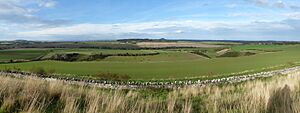Traprain Law facts for kids
Traprain Law is a famous hill in Scotland. It is about 6 kilometers (4 miles) east of Haddington, East Lothian. This hill was once home to a large ancient settlement, like a big fort, that covered about 16 hectares (40 acres). It is also known for the amazing Traprain Law Treasure. This was the biggest collection of Roman silver found outside the Roman Empire! It included beautiful silver objects.
The hill is about 220 meters (720 feet) high. People used it as a burial ground around 1500 BC. Later, after 1000 BC, people lived there and built defensive walls. These walls were rebuilt many times over the years. Digs show that people lived on Traprain Law from about 40 AD until the late 100s AD. This was around the time the Antonine Wall was used by the Romans.
After the Romans left to go back to Hadrian's Wall, people kept living on Traprain Law. They lived there from about 220 AD until around 400 AD. At that time, the old walls were replaced with even stronger ones. The site was left empty a few decades later.
In the 1st century AD, the Romans wrote about a British tribe called the Votadini who lived in this area. Many think Traprain Law was one of their main towns. The Romans called it Curia. Later, the Votadini became a kingdom called Gododdin. Traprain Law is believed to have been their capital city. They later moved their capital to Edinburgh's Castle Rock.
In 1938, part of the hill was used as a quarry to get stones for roads. This changed the look of the hill quite a bit.
Contents
What's in a Name?
The hill has only been called Traprain Law since the late 1700s. It got its name from a small nearby village. The name "Traprain" comes from an old language called Cumbric. It means "farm" and either "tree" or "hill." The word "Law" comes from an old English word meaning "hill."
Before that, old maps show the hill was called Dunpendyrlaw. This name appeared on a map in 1630. Another spelling, 'Dounprenderlaw', was used in 1547. That year, a signal fire was lit on the hill. It was a warning that the English were invading.
Local people, especially fishermen who use it as a landmark, still call it Dunpelder. This name also comes from the Cumbric language. It means "fort of the spear shafts." "Dun" can also come from the Scottish Gaelic word for "fort." In Mary Stewart's Merlin books, Traprain Law is called 'Dunpeldyr'. It is the capital of King Lot of Lothian.
Digging Up the Past
Teams of archaeologists started digging at Traprain Law in 1914. They continued until 1923. They found layers of stone and wooden houses under the ground.
The Traprain Treasure

In 1919, a man named Alexander Ormiston Curle found a hidden collection of silver objects. This amazing discovery was made in a pit within the old settlement. The collection weighed over 24 kilograms (53 pounds) and was made of Roman-era silver that had been cut into pieces.
Four Roman coins were found with the treasure. One coin was from Emperor Valens, three from Arcadius, and one from Honorius. These coins tell us the treasure was hidden sometime in the 400s AD. This was after the Romans had left Britain. Some of the silver items were very fancy. They might have come from far-off cities like Rome, Ravenna, Antioch, or Constantinople.
Most of the silver objects had been crushed and chopped into pieces. Only a few were still whole. A lot of the treasure was table silver, like plates and bowls. There were also early Christian items and parts of a Roman officer's uniform.
At first, people thought the silver was brought back from a raid in another country. This was because the objects were cut up, ready to be shared. But later finds showed that this type of silver was used in Roman Britain. Another idea is that the Votadini tribe brought the silver back after a raid across Hadrian's Wall. It has also been suggested that the silver was payment. The Votadini might have been paid to protect weaker tribes from other groups like the Scots, Picts, and Angles. The silver was cut up because there wasn't enough money (coins) to pay them.
More digs happened in 1939 and 1947. The silver collection was carefully put back together where possible. It was then sent to the National Museum of Antiquities in Edinburgh. Today, it is cared for by the Royal Museum of Scotland.
Old Stories and Legends
In old legends, Traprain Law is the cliff where Thenaw was thrown off. Thenaw was the mother of Saint Mungo. Her father, King Lot, found out she was going to have a baby with Owain mab Urien. But Thenaw was saved by a miracle! She was taken by boat to a community in Culross. There, she gave birth to Kentigern, who later became known as Mungo.
Photo gallery












